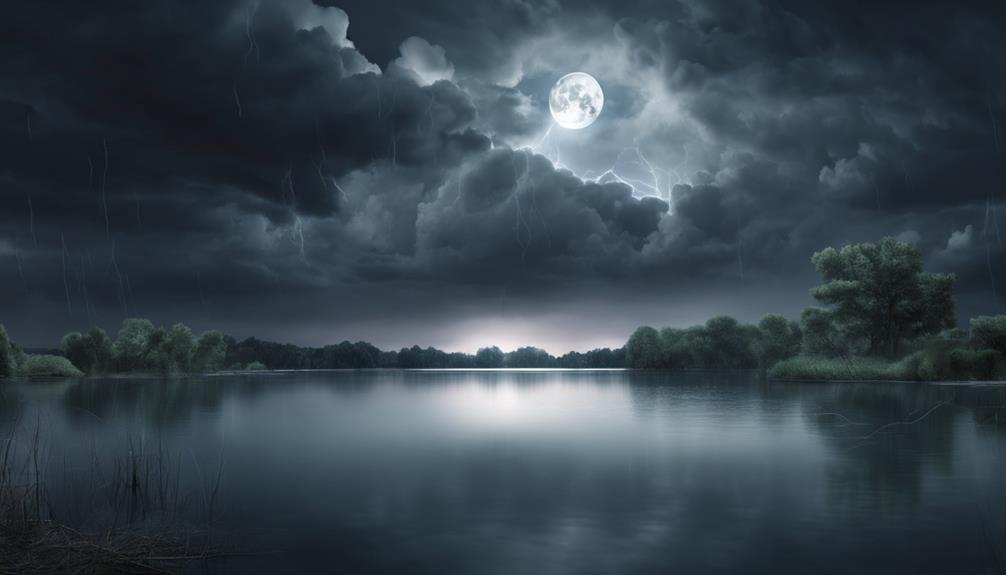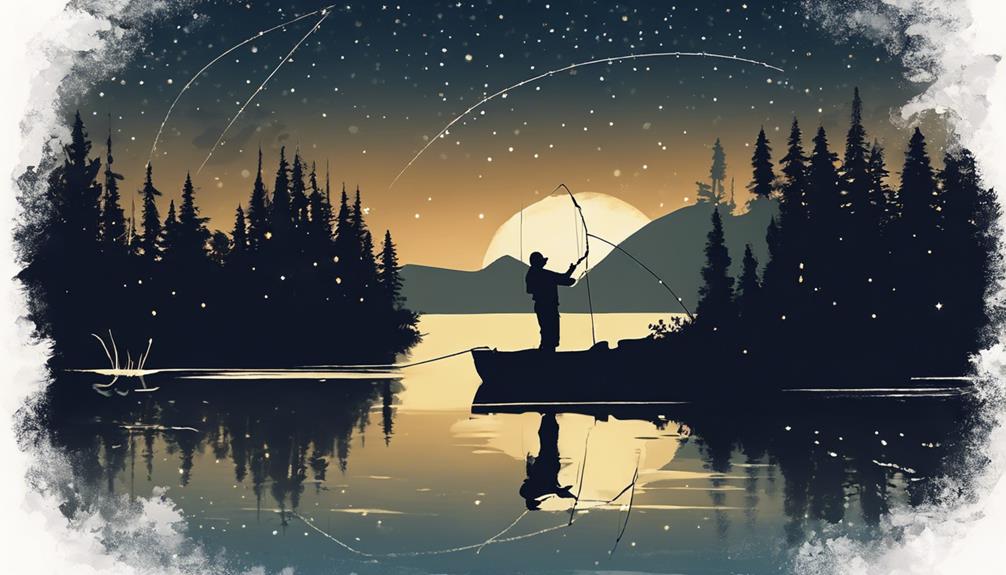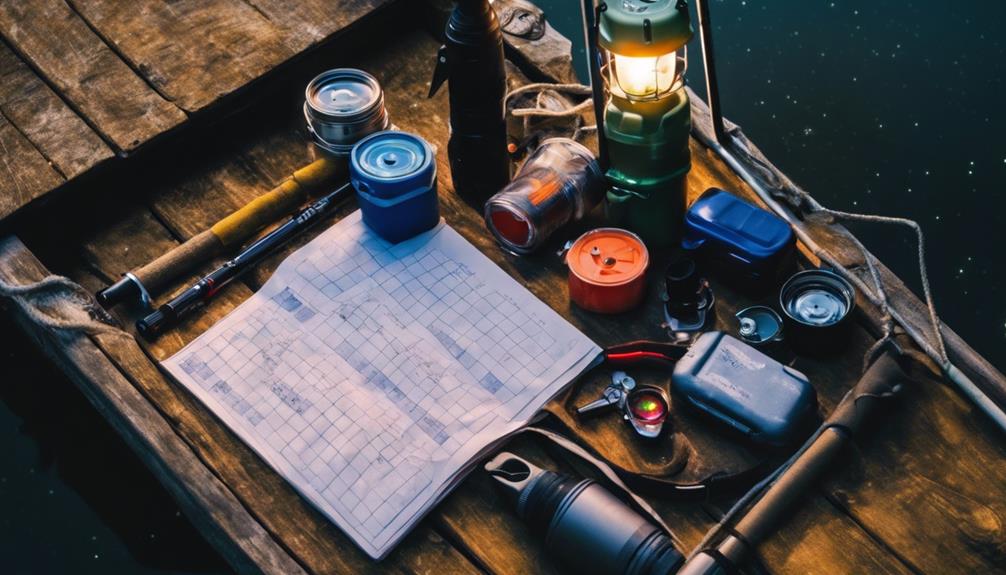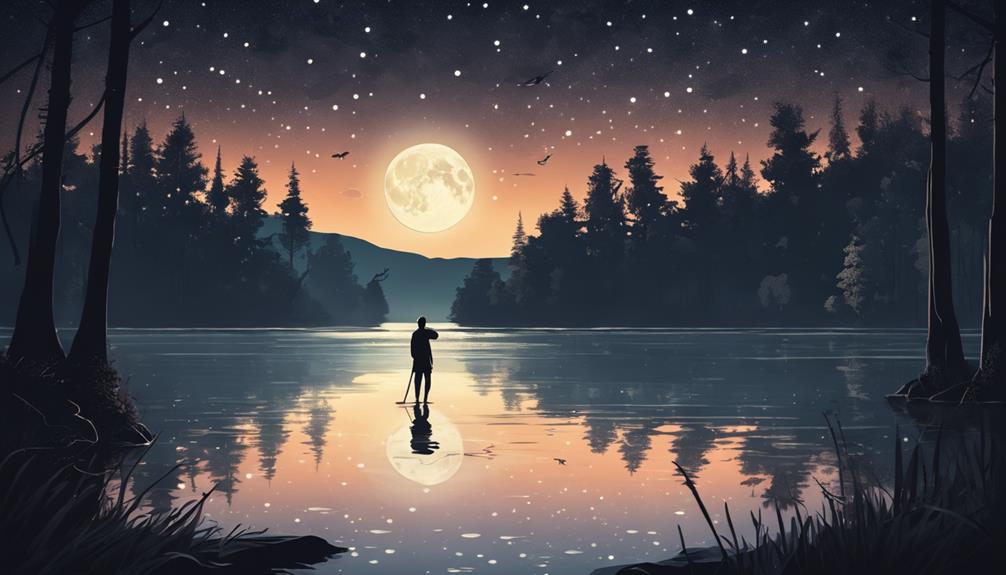Ready to crack the code for night walleye fishing success? Harness their exceptional night vision with the right gear like high-quality headlamps and lures that create vibrations. Explore rocky points and drop-offs for the best spots, and use live bait for bites. Master moonlight reflections for accurate casting and adjust techniques based on cloud cover and wind direction. Anticipate walleye movements with temperature changes. Remember, the key is in understanding their behavior at night to reel in that prized catch.
Understanding Walleye Behavior at Night
Discover how walleye behavior transforms under the cover of darkness, unlocking the secrets to successful night fishing adventures. When night falls, walleye rely on their exceptional night vision to navigate and hunt. Their eyes contain a high number of rods, specialized cells that enhance their ability to see in low light conditions. This superior night vision gives walleye a significant advantage over their prey, making them more active and aggressive during the dark hours.
Moon phases play a crucial role in walleye behavior at night. Walleye are known to be more active during certain moon phases, particularly around the full moon. During this time, the increased moonlight can make it easier for walleye to spot prey and feed more actively. On the other hand, during the new moon phase when the night sky is darker, walleye may be a bit more cautious and less aggressive in their feeding patterns. Understanding how moon phases affect walleye behavior can help you plan your night fishing expeditions more effectively.
Essential Night Fishing Gear for Walleye
Equipping yourself with the right gear is essential for a successful night fishing expedition targeting walleye. When venturing out into the dark waters, having proper night vision gear can make all the difference. Invest in a high-quality headlamp or cap light with red or green LEDs to preserve your night vision and avoid spooking the fish. These lights provide ample illumination without affecting your ability to see in the dark.
In addition to night vision aids, selecting the right tackle is crucial for hooking those elusive walleye. Opt for lures that create vibrations and rattles to attract walleye in low-light conditions. Jigging spoons, crankbaits, and soft plastic swimbaits are popular choices for night fishing. Since walleye are known to be light-sensitive, using lures that produce noise and movement can effectively trigger their predatory instincts.
Consider using glow-in-the-dark or UV-enhanced lures to increase visibility in the water and draw attention to your bait. These lures can be particularly effective when fishing in murky or dark conditions. Remember to pack a variety of tackle options to adapt to changing fishing conditions throughout the night.
Best Locations for Night Walleye Fishing
When seeking the best locations for night walleye fishing, consider exploring near shallow rocky points and drop-offs for optimal chances of landing these prized fish. Prime hotspots for walleye at night often include areas with structure, such as rocky points, where walleye tend to gather to hunt during low-light conditions. These locations provide ample opportunities to target walleye as they're known to patrol these areas in search of baitfish.
Ideal depths for night walleye fishing can vary but generally range from 10 to 20 feet deep. Walleye are nocturnal feeders and will move into shallower waters during the cover of darkness to feed, making these depths prime spots for anglers looking to hook into some walleye action. Drop-offs near shallow areas can also be productive as walleye use these transitions between depths to ambush prey.
When scouting for locations, look for underwater structures such as submerged rock piles, sunken trees, or weed beds near the shallows. These features attract baitfish, which in turn draw in walleye looking for an easy meal. By focusing your efforts around these prime hotspots and ideal depths, you increase your chances of success when night fishing for walleye.
Tips for Choosing the Right Bait
For successful night walleye fishing, selecting the right bait is crucial to enticing these nocturnal feeders and increasing your chances of a fruitful angling experience. When it comes to bait selection, consider using live bait such as minnows, leeches, or nightcrawlers. These natural baits release scents that can attract walleye even in low light conditions. Additionally, their movements in the water can grab the attention of these predatory fish, enhancing your chances of a successful catch.
Another important aspect to consider is the visibility of your bait in low light. Walleye have excellent night vision, so choosing brightly colored lures or baits that create contrast against the dark water can make them more noticeable. Opt for colors like chartreuse, orange, or glow-in-the-dark hues to make your bait stand out and increase its appeal to walleye prowling in the darkness.
Moon phases can also influence walleye feeding behavior. During a full moon, walleye tend to feed more actively at night, so adjusting your bait selection based on the moon phase can be beneficial. Experiment with different baits and observe how walleye respond to them under varying lunar conditions to optimize your chances of success.
Techniques for Casting at Night
As you prepare to cast your line into the darkness of the night waters, honing your casting technique becomes essential for maximizing your chances of hooking a walleye under the shimmering moonlight. The key to successful casting at night lies in mastering the art of moonlight reflections and adopting a stealthy approach.
When it comes to lure selection, opt for those that create enticing movements in the water, such as minnow imitations or jigs with reflective surfaces that catch the moon's glow. These lures can attract walleye by mimicking natural prey and reflecting light in a way that grabs their attention in the low-light conditions.
Moreover, controlling the depth of your lure is crucial for enticing walleye during nighttime fishing. Adjust the weight of your lure and the speed of your retrieve to ensure it swims at the right depth where walleye are likely to be hunting. Experiment with different retrieval speeds and depths until you find the sweet spot that triggers the walleye's predatory instincts.
Safety Precautions for Night Fishing
Ensuring your safety while night fishing is paramount to a successful and enjoyable angling experience. When venturing out after dusk, it's crucial to be well-prepared for any situation that may arise. Familiarize yourself with emergency procedures and have a plan in place. Keep a fully stocked first aid kit on hand and know how to use it. In case of emergencies, a basic knowledge of CPR can be a lifesaver.
Night vision is your best friend during nocturnal fishing escapades. Invest in a reliable headlamp or flashlight with a red light option to preserve your night vision. Red light is less likely to spook fish or disrupt your ability to see in the dark. Additionally, wearing reflective gear is vital for your safety. A reflective vest or tape will make you visible to other boaters and anglers, reducing the risk of accidents.
Navigation essentials are a must when navigating the waters in darkness. Carry a GPS device or a compass to help you find your way back to shore. Marking your starting point is also a good practice to ensure you can return safely. Stay vigilant and aware of your surroundings to avoid getting lost in the darkness. By adhering to these safety precautions, you can enjoy your night fishing adventures to the fullest.
Weather Considerations for Night Fishing

When night fishing, being mindful of weather conditions is crucial for a successful outing. The weather can greatly impact the behavior of walleye and your overall fishing experience. Consider the following key weather considerations:
- Moon Phase: The moon phase plays a significant role in walleye activity. During a full moon, walleye may feed more actively, while during a new moon, they might be less active. Understanding the moon phase can help you plan your night fishing trips effectively.
- Cloud Cover: Cloud cover can affect how well walleye can see your bait. On cloudy nights, walleye may feel more secure to venture out and feed. However, on clear nights, they might be more cautious. Keep an eye on the cloud cover to adjust your fishing techniques accordingly.
- Wind Direction: Pay attention to the wind direction as it can influence the movement of baitfish and subsequently attract walleye to certain areas. Fishing against the wind can also make it harder to control your boat, affecting your ability to fish effectively.
- Temperature Fluctuations: Sudden changes in temperature can trigger walleye to move to different depths or locations. Monitoring temperature fluctuations can help you anticipate where walleye might be located, increasing your chances of a successful catch.
Cleaning and Storing Walleye Catch
Monitoring the weather conditions not only enhances your night fishing experience but also influences how you clean and store your prized walleye catch. After a successful night of fishing, it's crucial to preserve the freshness of your walleye by cleaning them promptly. Start by scaling the fish and removing the entrails. Make sure to rinse the walleye thoroughly with cold water to remove any blood or debris. Pat the fish dry with paper towels to prevent any excess moisture that could lead to spoilage.
Proper packaging is key to maintaining the quality of your walleye catch. Consider vacuum-sealing the fillets to prevent freezer burn and prolong their shelf life. Alternatively, you can wrap the fillets tightly in plastic wrap before placing them in a resealable freezer bag. Remember to label the bags with the date of packaging to keep track of freshness.
When storing your walleye in the freezer, ensure it's set to the appropriate temperature to keep the fish frozen solid. Ideally, the freezer should be set to 0°F (-18°C) or lower. By following these steps and taking care in how you clean and store your walleye catch, you can enjoy the fruits of your night fishing labor for months to come.
Frequently Asked Questions
Can Walleye See Colors at Night?
At night, walleye have excellent night vision. They can see colors, although their vision is more sensitive to low light conditions.
When choosing lures for night fishing, consider using ones that create vibrations and have contrasting colors or glow-in-the-dark features. This will help attract walleye in the dark waters.
What Are the Best Times to Fish for Walleye at Night?
When fishing for walleye at night, timing is crucial. The best times depend on moon phases and weather conditions.
During the full moon, walleye are more active, so plan your night fishing trips around this phase. Additionally, cloudy nights can create ideal conditions for walleye feeding behavior.
Keep these factors in mind to increase your chances of a successful night fishing adventure.
How Can I Prevent Losing My Gear in the Dark?
When night fishing for walleye, tackle organization is key to preventing gear loss in the dark. Keep your gear neatly arranged and secure to avoid mishaps.
Utilize light sources strategically to illuminate your surroundings and make it easier to spot any loose equipment.
With a well-organized setup and proper lighting, you can navigate the darkness confidently and enjoy a successful fishing experience without the frustration of losing your gear.
Do Walleye Behave Differently During Full Moon Nights?
During full moon nights, walleye behavior can indeed be influenced by lunar phases. The brightness of the moonlight can impact their feeding patterns and movements.
Walleye have excellent night vision, allowing them to perceive their surroundings effectively. This heightened perception can make them more active and aggressive during full moon nights.
Understanding this lunar influence on walleye behavior can help you strategize your night fishing techniques for a successful catch.
Are There Specific Regulations for Night Fishing for Walleye?
When night fishing for walleye, it's crucial to know the specific regulations in place. These rules often include restrictions on fishing equipment to protect the fish population.
Make sure you're using the right gear and following all the night fishing regulations to ensure a successful and responsible fishing experience. By adhering to these guidelines, you can enjoy the thrill of night fishing while also contributing to the conservation of walleye populations.
Conclusion
Now that you've unlocked the secrets to night fishing for walleye, get out there and put your new knowledge to the test!
Remember to pack your essential gear, choose the right bait, and practice your casting techniques.
Stay safe, pay attention to weather conditions, and enjoy the thrill of reeling in those elusive walleye after the sun goes down.
Happy fishing!



